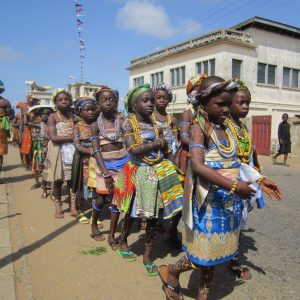Many festivals exist in the Anlo Kingdom, some of which date back to before the introduction of the main religions and are still occasions for spectacular displays of cultural traditions through dance and other acts. The Hogbetsotso festival, for example, is one of the enticing festivals of the Anlos, which attracts a large flood of tourists every year to Anloga, the people’s traditional and ritual capital, to see the different festivities.
The Anlos utilize the celebration to honor the exodus and the heroism of their traditional rulers, who rescued them from the tyrant King Agorkoli by perseverance and sacrifice every year on the first Saturday of November.
History of the festival.
Historians state that the term Hogbetsotso is composed of three Ewe words: Ho, meaning uproot or move, Gbe, meaning day, and Tsotso, meaning crossing over.. Hogbetsotso literally translates to “the day the people rose up and moved out of Notsie.”

Many believe that the Anlos migrated from Southern Sudan to Notsie, their ancestral federated region (now located in modern-day Togo), before finally settling on Ghana’s eastern coast in 1474, where they currently reside. The Anlos initially resided in Yorubaland, close to the Benin-Nigeria border, before relocating to Notsie in central Togo, according to history. The Ewes were treated so badly in Notsie by the evil King Agorkorli that they chose to flee. As a result, the people sought the advice of an elderly lady soothsayer, who informed them that the king was preparing to kill them and that they needed to find a means to flee the town. As a result, the slaves hatched a clever plan to flee the town.
The town where they resided was surrounded by a mud wall, making any attempt by the residents to flee extremely impossible. This wall was coated with human blood for spiritual reasons, making it difficult for anybody attempting to breach it. The key technique for allowing the ladies to flee was to have them discharge water on one side of the wall whenever they needed to dispose of filthy water. The wall became weak as a result, making it readily breakable and allowing them to flee. From Notsie, they eventually reached their current home
Activities
A day is set aside to showcase how the hostages’ escape or departure was orchestrated. To deceive the king and elders, the departing party marched backward, giving an impression of approaching rather than fleeing Notsie. Today, the Misego or Husago dance is used to reenact this event, mainly performed by ladies, especially young women. The dance includes backward movements and tunes appropriate to the occasion, making it a stunning spectacle to witness.

The third day of the celebration is the dodede and nugbidodo days. The dodede rite, which literally means ‘disease removal,’ entails the eradication of ailments as well as the expulsion of bad spirits believed to be the source of these maladies. People see Dodede as a private rite to connect with the Supreme God (Mawu), lower gods (trowo), and ancestors (togbinoliawo).
Nugbidodo means reconciliation. The residents of Anlo strive for peace among themselves at all times. The belief is that the ancestors dislike unresolved disagreements and misunderstandings because they bring illness and impede development.

Visitors should not miss Hanududu, where married landlords supply their wives with supplies to create meals and host an open house. The aim is to force people to feast together and reconcile, promoting harmony among family members, clans, and the public.
The climax of the festival is the durbar of chiefs and people held at Anloga. Music and dancing are essential components of any festival, and the Hogbetsotso is no different. During the durbar, people from all around Ghana, the Diaspora, and foreigners gather in large numbers to express respect for the paramount chief, who had hitherto avoided public visibility.
Experience the festival and relive the journey of the Anlos.



Comment (0)